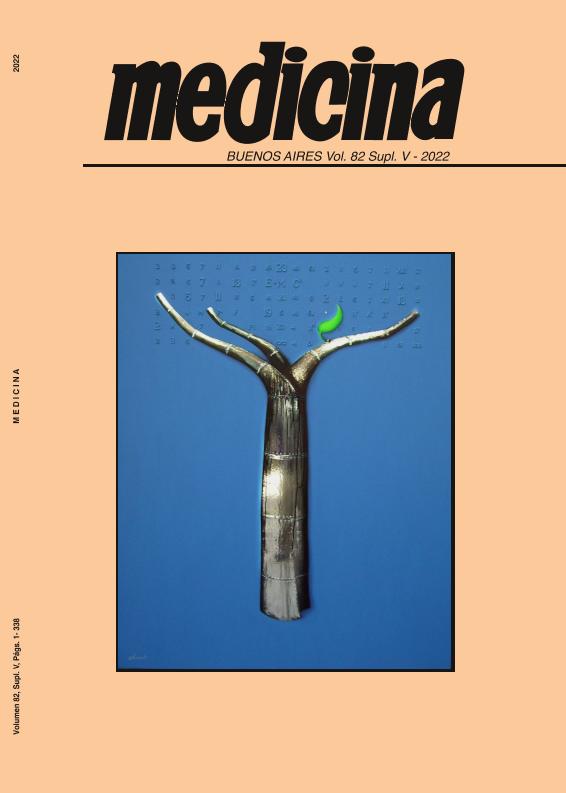Mostrar el registro sencillo del ítem
dc.contributor.author
Echevarria, Maria Sol

dc.contributor.author
Tenconi, Paula Estefania

dc.contributor.author
Mateos, Melina Valeria

dc.contributor.other
Alonso, Daniel Fernando

dc.contributor.other
Malchiodi, Emilio Luis

dc.contributor.other
Vila Petroff, Martin Gerarde

dc.contributor.other
Lamb, Caroline Ana

dc.date.available
2024-02-27T11:10:17Z
dc.date.issued
2022
dc.identifier.citation
Phospholipase D 1 and 2 inhibition prevents oxidative stress in retinal pigment epithelium cells exposed to high glucose levels; Reunión Anual de Sociedades de Biociencias 2022: LXVII Reunión Anual de la Sociedad Argentina de Investigación Clínica; LXX Reunión Anual de la Sociedad argentina de inmunología; Reunión anual 2022 de la Sociedad Argentina de Fisiología; Mar de plata; Argentina; 2022; 307-307
dc.identifier.issn
0025-7680
dc.identifier.uri
http://hdl.handle.net/11336/228497
dc.description.abstract
Objective: Oxidative stress (OE) and inflammation are involved in the pathogenesis of several retinal diseases. We previously demonstrated that classical phospholipase D isoforms (PLD1 and 2) mediate the inflammatory response of retinal pigment epithelium (RPE) cells induced by high glucose (HG) levels. Furthermore, a significant increase in reactive oxygen species (ROS) was observed in RPE cells exposed to HG. The aim of the present work was to study the relationship between OE and PLD activation observed in HG- treated RPE cells. Methods: RPE cells (ARPE-19) were exposed to HG (33 mM) or to normal glucose levels (NG, 5.5 mM) for 24 h. To inhibit PLD1, PLD2 and cyclooxygenase-2 (COX-2) VU0359595 (PLD1i, 0.5 μM), VU0285655-1 (PLD2i, 0.5 μM) or celecoxib (10 μM) were used, respectively. ROS production was assessed using the probe DCDCDHF. Immunocytochemistry assays (ICC) and western blots were performed to evaluate nuclear factor erythroid 2–related factor2 (Nrf-2) pathway. Results: HG-exposure for 24 h increased ROS levels (148%) in ARPE-19 cells with respect to NG. The incubation with PLD1i and PLD2i prevented HG-induced ROS generation in RPE cells. On the contrary, the inhibition of COX-2 was not able to prevent OE induced by HG. ICC showed Nrf-2 nuclear translocation in cells exposed to HG and this effect was not observed when cells were pre-treated with PLD1i and PLD2i. Nrf-2 activation correlated with and increased heme oxygenase-1 (HO-1) expression (42%) in HG-exposed cells but no differences were observed in cells treated with PLD1i or PLD2i with respect to NG. Conclusions: Our results demonstrate that PLD1 and PLD2 inhibition not only prevents the inflammatory response of RPE cells, but also decreases OE generated in RPE cells exposed to HG in a Nrf-2 and COX-2 independent manner. Further experiments are needed to fully elucidate the mechanisms by which the PLD pathway mediates OE in RPE cells exposed to inflammatory injury.
dc.format
application/pdf
dc.language.iso
eng
dc.publisher
Fundación Revista Medicina
dc.rights
info:eu-repo/semantics/openAccess
dc.rights.uri
https://creativecommons.org/licenses/by-nc-sa/2.5/ar/
dc.subject
PHOSPHOLIPASE D
dc.subject
RETINAL PIGMENT EPITHELIUM
dc.subject
OXIDATIVE STRESS
dc.subject.classification
Bioquímica y Biología Molecular

dc.subject.classification
Ciencias Biológicas

dc.subject.classification
CIENCIAS NATURALES Y EXACTAS

dc.title
Phospholipase D 1 and 2 inhibition prevents oxidative stress in retinal pigment epithelium cells exposed to high glucose levels
dc.type
info:eu-repo/semantics/publishedVersion
dc.type
info:eu-repo/semantics/conferenceObject
dc.type
info:ar-repo/semantics/documento de conferencia
dc.date.updated
2024-02-22T14:03:10Z
dc.identifier.eissn
1669-9106
dc.journal.volume
82
dc.journal.number
Suplemento V
dc.journal.pagination
307-307
dc.journal.pais
Argentina

dc.journal.ciudad
Buenos Aires
dc.description.fil
Fil: Echevarria, Maria Sol. Consejo Nacional de Investigaciones Científicas y Técnicas. Centro Científico Tecnológico Conicet - Bahía Blanca. Instituto de Investigaciones Bioquímicas de Bahía Blanca. Universidad Nacional del Sur. Instituto de Investigaciones Bioquímicas de Bahía Blanca; Argentina. Universidad Nacional del Sur. Departamento de Biología, Bioquímica y Farmacia; Argentina
dc.description.fil
Fil: Tenconi, Paula Estefania. Consejo Nacional de Investigaciones Científicas y Técnicas. Centro Científico Tecnológico Conicet - Bahía Blanca. Instituto de Investigaciones Bioquímicas de Bahía Blanca. Universidad Nacional del Sur. Instituto de Investigaciones Bioquímicas de Bahía Blanca; Argentina. Universidad Nacional del Sur. Departamento de Biología, Bioquímica y Farmacia; Argentina
dc.description.fil
Fil: Mateos, Melina Valeria. Consejo Nacional de Investigaciones Científicas y Técnicas. Centro Científico Tecnológico Conicet - Bahía Blanca. Instituto de Investigaciones Bioquímicas de Bahía Blanca. Universidad Nacional del Sur. Instituto de Investigaciones Bioquímicas de Bahía Blanca; Argentina. Universidad Nacional del Sur. Departamento de Biología, Bioquímica y Farmacia; Argentina
dc.relation.alternativeid
info:eu-repo/semantics/altIdentifier/url/https://www.saic.org.ar/revista-medicina
dc.conicet.rol
Autor

dc.conicet.rol
Autor

dc.conicet.rol
Autor

dc.coverage
Nacional
dc.type.subtype
Congreso
dc.description.nombreEvento
Reunión Anual de Sociedades de Biociencias 2022: LXVII Reunión Anual de la Sociedad Argentina de Investigación Clínica; LXX Reunión Anual de la Sociedad argentina de inmunología; Reunión anual 2022 de la Sociedad Argentina de Fisiología
dc.date.evento
2022-11-16
dc.description.ciudadEvento
Mar de plata
dc.description.paisEvento
Argentina

dc.type.publicacion
Journal
dc.description.institucionOrganizadora
Sociedad Argentina de Investigación Clínica
dc.description.institucionOrganizadora
Sociedad Argentina de Inmunología
dc.description.institucionOrganizadora
Sociedad Argentina de Fisiología
dc.source.revista
Medicina (Buenos Aires)

dc.date.eventoHasta
2022-11-19
dc.type
Congreso
Archivos asociados
